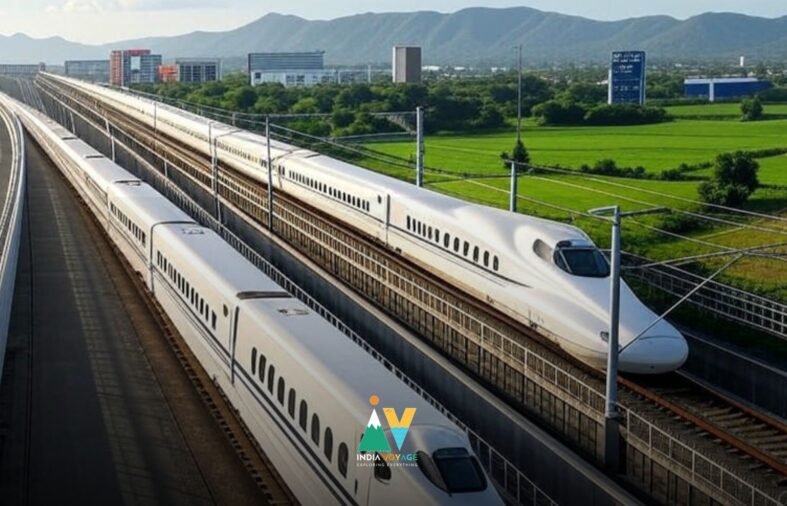India is on the cusp of a transportation revolution with its first bullet train project, the Mumbai-Ahmedabad High-Speed Rail (MAHSR) corridor. This ambitious initiative promises to redefine travel between two of India’s economic powerhouses, Mumbai and Ahmedabad, slashing travel time and introducing cutting-edge Japanese Shinkansen technology to the subcontinent. As trials commence and infrastructure takes shape, the project is both a symbol of India’s modernization and a lightning rod for debate. This article explores the journey, progress, and potential of India’s bullet train dream.
A Vision of Speed and Connectivity
The MAHSR corridor, spanning 508 kilometers, is designed to connect Mumbai, India’s financial capital, with Ahmedabad, Gujarat’s commercial hub, in just over two hours. Operating at speeds up to 320 km/h, the bullet train will reduce the current rail journey of 7-8 hours to a mere 2 hours and 7 minutes for limited-stop services. The corridor will feature 12 stations, including Thane, Surat, Vadodara, and Sabarmati, knitting together key cities and fostering economic growth.
The project, spearheaded by the National High Speed Rail Corporation Limited (NHSRCL), is a collaboration between India and Japan. Japan’s Shinkansen, renowned for its impeccable safety record and precision, serves as the technological backbone. With Japan providing two train sets for free and a low-interest loan covering 81% of the project’s cost, this partnership underscores the strategic alliance between the two nations.
Progress on the Ground
As of June 2025, the project is making steady strides. Over 300 kilometers of viaduct construction has been completed, primarily in Gujarat, with the Surat-Bilimora stretch nearing readiness for trial runs by August 2026. The first bullet train station in Surat is almost complete, marking a tangible milestone. In Japan, trials of the E3 series L67 and E5 series Shinkansen trains have begun, with these trains set to arrive in India by early 2026. Commercial operations in Gujarat are targeted for 2028, with the full Mumbai-Ahmedabad route operational by 2030.
The project’s infrastructure is a marvel in itself. Elevated viaducts, earthquake-resistant designs, and advanced signaling systems reflect the engineering precision required for high-speed rail. The trains are being adapted to withstand India’s humid and dusty climate, ensuring reliability in diverse conditions.
Economic and Social Impact
The bullet train is poised to transform more than just travel times. By linking Mumbai and Ahmedabad, it will boost tourism, create thousands of jobs, and stimulate economic activity along the corridor. The project is expected to enhance connectivity to industrial hubs like Surat and Vadodara, fostering regional development. Affordable fares, potentially lower than air travel, could make high-speed rail accessible to a broad segment of the population, democratizing fast travel.
Beyond economics, the bullet train symbolizes India’s aspirations to join the league of nations with advanced rail systems. It represents a shift from colonial-era railways to a future of innovation, aligning with India’s broader push for modernization.
Challenges and Controversies
Despite its promise, the MAHSR project has faced significant hurdles. Initially budgeted at ₹1.1 lakh crore, costs have ballooned to over ₹1.6 lakh crore, with estimates suggesting a final tally exceeding ₹2 lakh crore. Land acquisition delays, particularly in Maharashtra, have pushed the timeline far beyond the original 2022 target. Construction mishaps, such as crane accidents, have raised safety concerns, while critics argue that the project’s cost outweighs its benefits in a country with pressing needs like healthcare and education.
Public sentiment is divided. Supporters view the bullet train as a game-changer, heralding India’s entry into the “bullet train club.” Detractors, however, point to delays and escalating costs, labeling it an expensive vanity project. These debates highlight the challenge of balancing ambition with pragmatism in India’s infrastructure journey.
Looking Ahead
The MAHSR corridor is more than a railway—it’s a test of India’s ability to execute mega-projects. With trials underway and infrastructure taking shape, the project is moving closer to reality. The success of this corridor could pave the way for additional high-speed rail lines, potentially connecting other major cities. Moreover, the adoption of advanced Shinkansen models, like the E10 (Alfa-X) by 2030, could further elevate India’s rail capabilities.











Leave A Reply